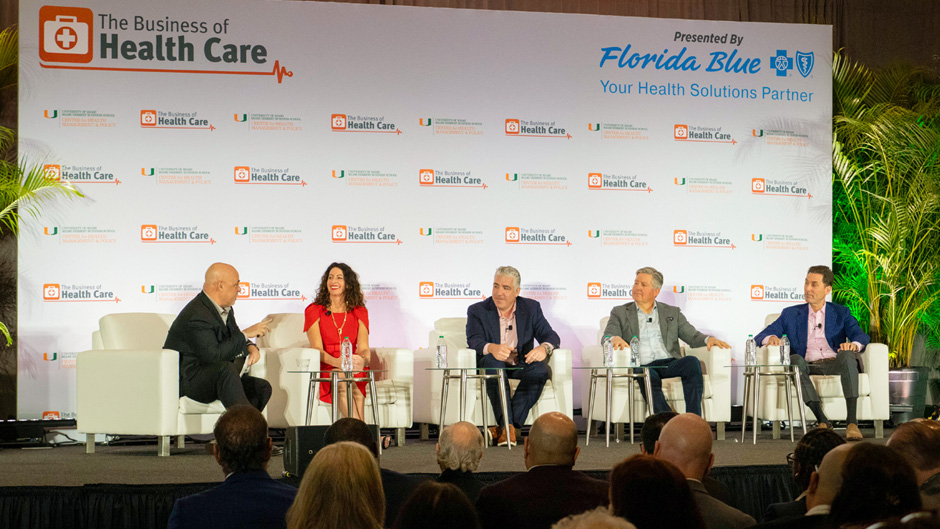Presidents and CEOs representing the nation’s major health care associations and organizations highlighted the importance of improving affordability and access for all, especially for people of limited means, and vowed to work more collaboratively to reduce system inefficiencies during sessions held at the University of Miami 14th annual Business of Health Care Conference.
The half-day conference, which was hosted by the Center for Health Management and Policy in the Miami Herbert Business School, took place Jan. 24 at the Donna E. Shalala Student Center and offered leaders a first chance to envision how the industry will be impacted by policies and orders proposed by the new administration.
Paul. A. Pavlou, Miami Herbert dean and Leonard M. Miller University Chair Professor, welcomed the 800 audience attendees.
“I see great promise in personalized care with the power of data, of analytics; the power that electronic medical systems provide to enhance personalized care, diagnosis, and treatment, not only in the U.S. but to work across the globe with telemedicine, reaching out to populations that have been underserved for many years,” said Pavlou.
Patrick J. Geraghty, president and CEO of major sponsors GuideWell and Florida Blue, moderated two keynote panels, “The Election Impact on U.S. Health Care” and “Navigating in 2025 and Beyond.”
Mike Tuffin, president and CEO of America’s Health Insurance Plans (AHIP), expressed his hope that the new administration and industry leaders would find ways to work together to address this imposing landscape: an aging national and global population with rising incidences of chronic disease and health conditions.
“The issues we’re grappling with really transcend politics,” Tuffin said. “Health care is the largest sector of the world’s largest economy, and we shouldn’t overweight government and politics—the challenges have transcended party and politics for some time now.”
Tuffin urged the need for a collaborative approach to address the industry’s challenges.
“The current trajectory is not sustainable,” Tuffin said. “We need a much less adversarial system, and instead one that is more transparent and rooted in value—that’s a pathway towards sustainability.”
“Yet aging is not the problem; the issue is the ratio of the people who need care and the people who might provide care is compressed, which means a higher portion of the vibrant care need to be working and caring so that they can get the care they need,” said Dr. Steven Landers, CEO of the National Alliance for Care at Home. “Expanding the workforce is the preeminent health care problem.”
Dr. Virginia A. Caine, president of the National Medical Association, urged working with the new administration to create a more level or equal playing field to improve health care and health care outcomes.
“When we look at the poverty levels with different populations and in different areas, access and affordability are critical,” said Caine, whose organization represents the Black community and other racial ethnic populations that have limited resources.
“We have to find a way to do health care differently,” she added. “And here’s where the opportunity comes: to not only educate our policymakers but also the public to understand critical care, how many in their own families depend on access to it.”
Jennifer Mensik Kennedy, president of the American Nurses Association, among others, echoed the importance of educating and communicating with the public at large and the new administration, comprised of many new directors of health care agencies who are nontraditional health care actors.
“Many individuals don’t really understand how the Affordable Care Act (ACA) benefits, cares for, and provides some access of care that they did not have in 2012,” said Mensik Kennedy.
When questioned, the panelists agreed unanimously to maintain and continue to improve the ACA, whose enhanced subsidies could expire by the end of 2025. They were concerned by the politicalization that has seeped into the health care industry.
As an example, Dr. Halee Fischer-Wright, president and CEO of the Medical Group Management Association, referenced a survey her organization had conducted where 50 percent rejected the idea of maintaining “Obamacare,” but most respondents voted to keep the “ACA.” The two are the same initiative, only referenced by different names.
Dr. Bruce A. Scott, president of the American Medical Association, the largest organization of students and practicing physicians, expressed his concern that for the past five years the payment to physicians in Medicaid has been cut, a trend that is contributing to a dearth in physicians participating in the program.
Ann Jordan, president and CEO, Healthcare Financial Management Association, emphasized the importance of collaboration to manage the cascade of complex issues that health care poses.
“My association does not lobby. We are numbers people who try to eliminate the emotional side and read between the tea leaves,” Jordan said. “It’s so complex what we’re hearing from many of the new government health care leaders, many of whom are nontraditional. We know about their whole focus of eliminating costs; what we can control is the approach we’re taking and what we in the industry can do together to improve the system.”
To a round of questions devoted to the evolving impact of artificial intelligence, panelists emphasized the importance of keeping the “human element” foremost in the conversation.
Steven Ullmann, professor and director of Miami Herbert’s Center for Health Management and Policy, and Karoline Mortensen, professor, associate dean, and associate director of the center, managed the lightning round recap and Q&A session.
To one of the questions, Scott reemphasized the importance of informing legislators who will be developing or adjusting policy relating to health care.
“We need all of you to communicate with your legislators. We need to educate those who are fiscal hawks that we will have cost savings by making sure that people have access to affordable care,” Scott said. “Otherwise, they’re going to wind up in the emergency clinic. The difference in that cost of care is tremendous. This is really about taking care of people.”

